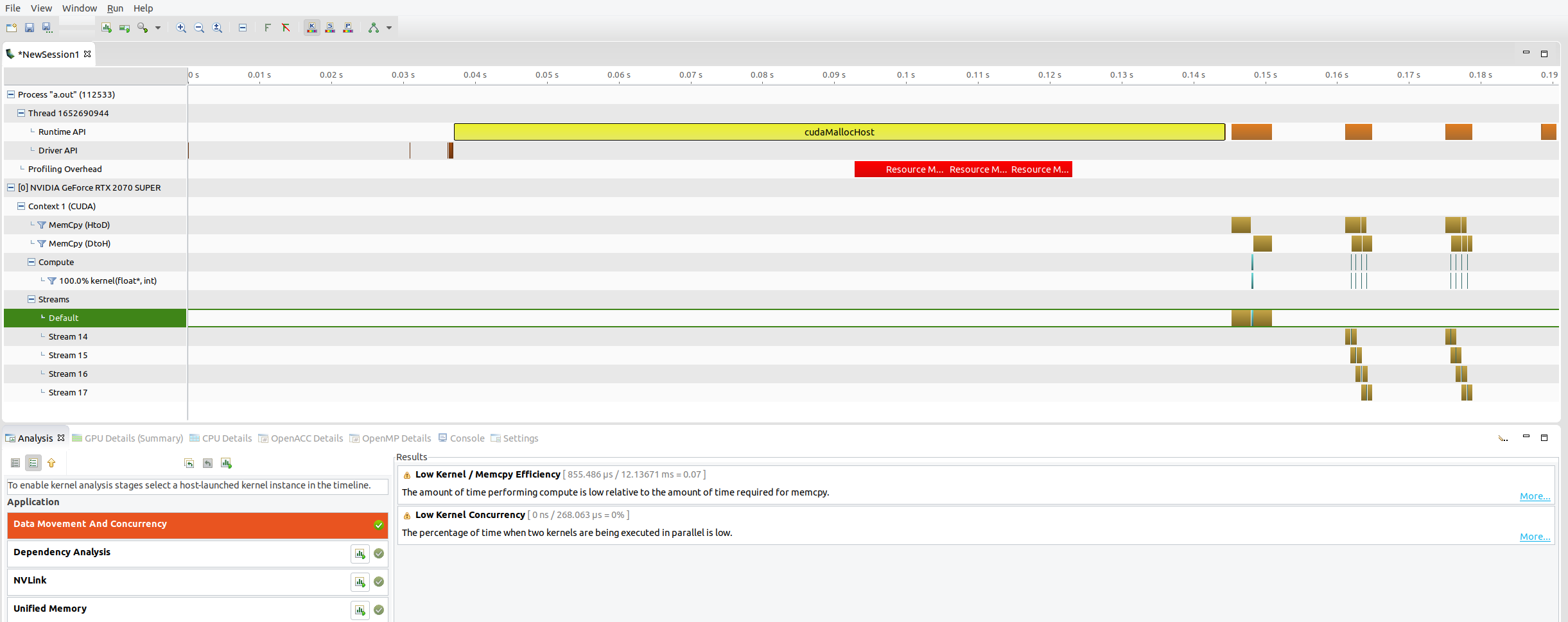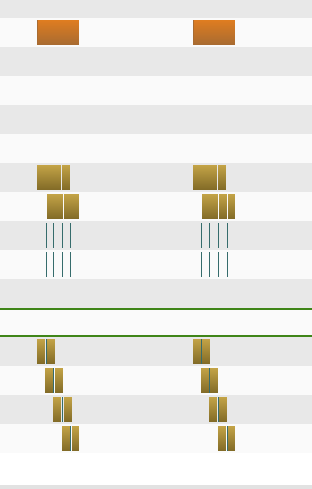接前文:
TensorFlow和pytorch中的pin_memory和non_blocking设置是做什么的,又是否有用???
TensorFlow和pytorch中的pin_memory和non_blocking设置是做什么的,又是否有用???(续)
参考:
如何实现nvidia显卡的cuda的多kernel并发执行???
===========================================
关于How to Overlap Data Transfers in CUDA C/C++中的介绍内容还有一部分没有交代,这里继续。
Demo代码:

/* Copyright (c) 1993-2015, NVIDIA CORPORATION. All rights reserved. * * Redistribution and use in source and binary forms, with or without * modification, are permitted provided that the following conditions * are met: * * Redistributions of source code must retain the above copyright * notice, this list of conditions and the following disclaimer. * * Redistributions in binary form must reproduce the above copyright * notice, this list of conditions and the following disclaimer in the * documentation and/or other materials provided with the distribution. * * Neither the name of NVIDIA CORPORATION nor the names of its * contributors may be used to endorse or promote products derived * from this software without specific prior written permission. * * THIS SOFTWARE IS PROVIDED BY THE COPYRIGHT HOLDERS ``AS IS'' AND ANY * EXPRESS OR IMPLIED WARRANTIES, INCLUDING, BUT NOT LIMITED TO, THE * IMPLIED WARRANTIES OF MERCHANTABILITY AND FITNESS FOR A PARTICULAR * PURPOSE ARE DISCLAIMED. IN NO EVENT SHALL THE COPYRIGHT OWNER OR * CONTRIBUTORS BE LIABLE FOR ANY DIRECT, INDIRECT, INCIDENTAL, SPECIAL, * EXEMPLARY, OR CONSEQUENTIAL DAMAGES (INCLUDING, BUT NOT LIMITED TO, * PROCUREMENT OF SUBSTITUTE GOODS OR SERVICES; LOSS OF USE, DATA, OR * PROFITS; OR BUSINESS INTERRUPTION) HOWEVER CAUSED AND ON ANY THEORY * OF LIABILITY, WHETHER IN CONTRACT, STRICT LIABILITY, OR TORT * (INCLUDING NEGLIGENCE OR OTHERWISE) ARISING IN ANY WAY OUT OF THE USE * OF THIS SOFTWARE, EVEN IF ADVISED OF THE POSSIBILITY OF SUCH DAMAGE. */ #include <stdio.h> // Convenience function for checking CUDA runtime API results // can be wrapped around any runtime API call. No-op in release builds. inline cudaError_t checkCuda(cudaError_t result) { #if defined(DEBUG) || defined(_DEBUG) if (result != cudaSuccess) { fprintf(stderr, "CUDA Runtime Error: %s\n", cudaGetErrorString(result)); assert(result == cudaSuccess); } #endif return result; } __global__ void kernel(float *a, int offset) { int i = offset + threadIdx.x + blockIdx.x*blockDim.x; float x = (float)i; float s = sinf(x); float c = cosf(x); a[i] = a[i] + sqrtf(s*s+c*c); } float maxError(float *a, int n) { float maxE = 0; for (int i = 0; i < n; i++) { float error = fabs(a[i]-1.0f); if (error > maxE) maxE = error; } return maxE; } int main(int argc, char **argv) { const int blockSize = 256, nStreams = 4; const int n = 4 * 1024 * blockSize * nStreams; const int streamSize = n / nStreams; const int streamBytes = streamSize * sizeof(float); const int bytes = n * sizeof(float); int devId = 0; if (argc > 1) devId = atoi(argv[1]); cudaDeviceProp prop; checkCuda( cudaGetDeviceProperties(&prop, devId)); printf("Device : %s\n", prop.name); checkCuda( cudaSetDevice(devId) ); // allocate pinned host memory and device memory float *a, *d_a; checkCuda( cudaMallocHost((void**)&a, bytes) ); // host pinned checkCuda( cudaMalloc((void**)&d_a, bytes) ); // device float ms; // elapsed time in milliseconds // create events and streams cudaEvent_t startEvent, stopEvent, dummyEvent; cudaStream_t stream[nStreams]; checkCuda( cudaEventCreate(&startEvent) ); checkCuda( cudaEventCreate(&stopEvent) ); checkCuda( cudaEventCreate(&dummyEvent) ); for (int i = 0; i < nStreams; ++i) checkCuda( cudaStreamCreate(&stream[i]) ); // baseline case - sequential transfer and execute memset(a, 0, bytes); checkCuda( cudaEventRecord(startEvent,0) ); checkCuda( cudaMemcpy(d_a, a, bytes, cudaMemcpyHostToDevice) ); kernel<<<n/blockSize, blockSize>>>(d_a, 0); checkCuda( cudaMemcpy(a, d_a, bytes, cudaMemcpyDeviceToHost) ); checkCuda( cudaEventRecord(stopEvent, 0) ); checkCuda( cudaEventSynchronize(stopEvent) ); checkCuda( cudaEventElapsedTime(&ms, startEvent, stopEvent) ); printf("Time for sequential transfer and execute (ms): %f\n", ms); printf(" max error: %e\n", maxError(a, n)); // asynchronous version 1: loop over {copy, kernel, copy} memset(a, 0, bytes); checkCuda( cudaEventRecord(startEvent,0) ); for (int i = 0; i < nStreams; ++i) { int offset = i * streamSize; checkCuda( cudaMemcpyAsync(&d_a[offset], &a[offset], streamBytes, cudaMemcpyHostToDevice, stream[i]) ); kernel<<<streamSize/blockSize, blockSize, 0, stream[i]>>>(d_a, offset); checkCuda( cudaMemcpyAsync(&a[offset], &d_a[offset], streamBytes, cudaMemcpyDeviceToHost, stream[i]) ); } checkCuda( cudaEventRecord(stopEvent, 0) ); checkCuda( cudaEventSynchronize(stopEvent) ); checkCuda( cudaEventElapsedTime(&ms, startEvent, stopEvent) ); printf("Time for asynchronous V1 transfer and execute (ms): %f\n", ms); printf(" max error: %e\n", maxError(a, n)); // asynchronous version 2: // loop over copy, loop over kernel, loop over copy memset(a, 0, bytes); checkCuda( cudaEventRecord(startEvent,0) ); for (int i = 0; i < nStreams; ++i) { int offset = i * streamSize; checkCuda( cudaMemcpyAsync(&d_a[offset], &a[offset], streamBytes, cudaMemcpyHostToDevice, stream[i]) ); } for (int i = 0; i < nStreams; ++i) { int offset = i * streamSize; kernel<<<streamSize/blockSize, blockSize, 0, stream[i]>>>(d_a, offset); } for (int i = 0; i < nStreams; ++i) { int offset = i * streamSize; checkCuda( cudaMemcpyAsync(&a[offset], &d_a[offset], streamBytes, cudaMemcpyDeviceToHost, stream[i]) ); } checkCuda( cudaEventRecord(stopEvent, 0) ); checkCuda( cudaEventSynchronize(stopEvent) ); checkCuda( cudaEventElapsedTime(&ms, startEvent, stopEvent) ); printf("Time for asynchronous V2 transfer and execute (ms): %f\n", ms); printf(" max error: %e\n", maxError(a, n)); // cleanup checkCuda( cudaEventDestroy(startEvent) ); checkCuda( cudaEventDestroy(stopEvent) ); checkCuda( cudaEventDestroy(dummyEvent) ); for (int i = 0; i < nStreams; ++i) checkCuda( cudaStreamDestroy(stream[i]) ); cudaFree(d_a); cudaFreeHost(a); return 0; }
这个代码是关于overlap data transfer的,原文中给出的是比较老的显卡环境,为此我在2070super显卡上运行,结果如下:
Device : NVIDIA GeForce RTX 2070 SUPER
Time for sequential transfer and execute (ms): 5.685216
max error: 1.192093e-07
Time for asynchronous V1 transfer and execute (ms): 4.635808
max error: 1.192093e-07
Time for asynchronous V2 transfer and execute (ms): 4.183488
max error: 1.192093e-07
上面代码每次运行都是对同一任务使用三次不同GPU调用方式:
第一次,是对总的计算任务用一个和host同步的cudaMemcpy函数实现数据从host到device的传输,然后使用一个stream队列进行kernel运算,最后再将计算好的结果用一个和host同步的cudaMemcpy函数实现数据从device到host的传输;
第二次,是将总的计算任务划分多个子计算任务,以子任务为单位循环的调用每个子计算任务中的从host到device的cudaMemcpy数据传输、单独stream队列的kernel运算、计算结果从device到host的cudaMemcpy数据传输;
第三次,是将总的计算任务划分多个子计算任务,首先执行完所有子计算任务中的从host到device的cudaMemcpy数据传输,然后执行完每个子任务各自stream队列的kernel运算,最后将各子任务的计算结果从device到host的cudaMemcpy数据传输。
使用nvvp查看上面代码运行是CUDA的运行情况:


可以看到第二次GPU的调用和第三次的运行图是差不多的,甚至是几乎一样的,那么为啥第三次要比第二次运行时间短呢,没有想到什么比较好的解释。
=============================================
pytorch代码中pin_memory和non_blocking设置性能对比代码(CPU 10700k 5.0Ghz,GPU 2070 super):

import torch import time _x = torch.arange(1000000,2000000, device="cpu") _y = torch.arange(2000000,3000000, device="cpu") _z = torch.arange(3000000,4000000, device="cpu") _k = torch.arange(3000000,4000000, device="cpu") _p = torch.arange(3000000,4000000, device="cpu") a_time = time.time() x = _x.to("cuda:1") b_time = time.time() print("pytorch的显存管理机制,为保证公平在显存中预先申请空间","用时:", b_time - a_time) del x time.sleep(3) a_time = time.time() y = _y.to("cuda:1") b_time = time.time() print(b_time - a_time) del y time.sleep(3) a_time = time.time() z = _z.to("cuda:1", non_blocking=True) b_time = time.time() print(b_time - a_time) del z time.sleep(3) _k = torch.Tensor.pin_memory(_k) a_time = time.time() k = _k.to("cuda:1", non_blocking=True) b_time = time.time() print("{:<10f}".format(b_time - a_time)) del k time.sleep(3) _p = torch.Tensor.pin_memory(_p) a_time = time.time() p = _p.to("cuda:1") b_time = time.time() print("{:<10f}".format(b_time - a_time)) del p time.sleep(30)
运行结果:





第一条时间是不使用pin_memory和non_blocking参数后的代码,用时最长;
第二条时间是设置non_blocking参数后的代码;
第三条时间是设置pin_memory和non_blocking参数后的代码;
第四条时间是设置pin_memory参数后的代码;
可以看到,同时设置pin_memory和non_blocking参数后的代码运行时间最短;单独设置pin_memory或non_blocking参数后的代码虽然也可以缩短时间但是缩小的幅度不大;只设置pin_memory参数后的代码比只设置non_blocking参数后的代码运行时间快,但是个人观点不认为这个数据可以说明pin_memory就比non_blocking的效果好,由于pytorch本身是对cuda的包装,不能把pytorch的运行效果和naive的CUDA代码等同来看,个人认为不管是是只设置pin_memory还是只设置non_blocking都是需要CPU进行一定的操作的,而在pytorch中很可能只要CPU启动开始做这样的操作都需要一定的时间花费,所以导致只加pin_memory参数和只加non_blocking参数与什么参数都不加的情况也没有太大的提速,而只有不需要CPU做任何操作的两个参数全加的情况还得到了极大的提速效果。
必须要注意的是,即使使用pin_memory和non_blocking参数其主要功能就是使CPU的操作和GPU的copy操作同时运行,其所提高的效率就是CPU避免了阻塞,但是如果CPU立刻再次调用GPU中的model则会隐式implicit的进行再次同步,这样就失去了设置参数的作用,为此给出例子:
不能实现CPU提速的操作,implicit的隐式的再次阻塞CPU:
_k = torch.Tensor.pin_memory(_k)
k = _k.to("cuda:1", non_blocking=True)
target=model(k) // 神经网络
cpu_fun()
可以提高CPU效率的形式:
_k = torch.Tensor.pin_memory(_k)
k = _k.to("cuda:1", non_blocking=True)
cpu_fun()
target=model(k) // 神经网络
其实说白了,就是不阻塞CPU后要CPU做一些和GPU无关联的操作后再必须和GPU同步的时候再同步,由此通过减少CPU阻塞来释放一定的CPU运算能力。
===========================================================
